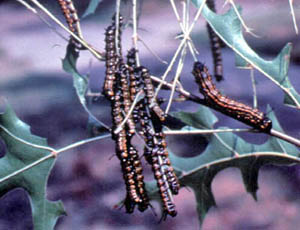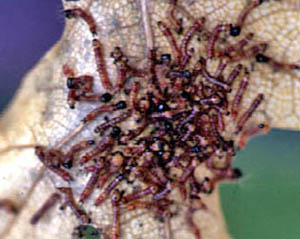Orangestriped Oakworm (Anisota senatoria)


Adult moths are about 1-1/4 inches long with wings closed. They are reddish brown, translucent, with a submarginal dark stripe and a white spot on each forewing. Mature larvae are about 1-1/2 inch long. They are black with eight orange-to-yellow stripes and two black spines behind the head. Adults first appear in early summer. Pupae overwinter in soil.
This native notodontid moth caterpillar prefers to feed on oaks, but it also attacks hickory and birch.
The caterpillars are gregarious and early instars feed by skeletonizing the leaf surface. Older caterpillars are defoliators and may consume all but the leaf midrib. Defoliation usually occurs one branch at a time when populations are small.
Look for signs of localized skeletonization turning to defoliation on host tree branches. Where this species is a serious problem, a black-light trap can be used to determine the first adult appearance and the relative size of each generation.
Manually destroy aggregations of young larvae when they are detected on small trees. Application of Bacillus thuringiensis or horticultural oil will control young larvae. Contact insecticides often are required to control large caterpillars.
